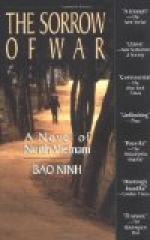|
This section contains 883 words (approx. 3 pages at 400 words per page) |

|
Part 2, pp. 39 - 72 Summary
Through the first-person narration offered in the present time, which is eventually revealed to be Kien's journal or diary, the reader learns how Kien is still profoundly traumatized fourteen years after the war. The narrator describes the horrors of Kien's dreams, his experiences on the street when sudden smells remind him of the slaughters he witnessed, and how all the efforts of the past have been useless. The narration then shifts into the third person perspective and the present tense as it describes Kien's painstaking writing process, his obsession with detail, and his belief that his writing is a manifestation of his ultimate divine purpose. He believes that this purpose is ultimately connected to his survival of the war. Finally, the narrator describes how Kien first felt this sense of purpose during his post-war missions gathering dead bodies.
Kien...
(read more from the Part 2, pp. 39 - 72 Summary)
|
This section contains 883 words (approx. 3 pages at 400 words per page) |

|




